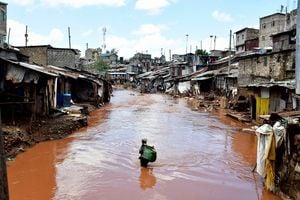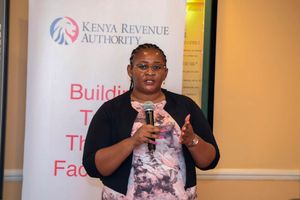Too much water, too little food as Mother Nature fights back

In the last 28 years, temperatures have risen.
What you need to know:
- Already, flash floods have been experienced in the Tana Delta
- The WMO says 2020 was one of the three warmest years on record despite a cooling La Niña event
- Just last week, Mombasa County announced cases of dengue fever
At least 1.4 million Kenyans are hungry and another 30,000 are on the verge of losing their homes due to floods.
With locusts still breeding in northern Kenya, the country is experiencing multiple hazards. At the same time, the effects of climate change are clear and the country is still dealing with the Covid-19 pandemic.
While some places are experiencing flooding, some areas have been struck by drought and food shortage.
The Kenya Red Cross Society (KRCS) says the food situation is worsening by the day in arid and semi-arid counties.
Kenya experienced La Niña conditions in January and February, which added to the poor short rains of October-November-December in 2020.
According to the Climate Prediction Center’s Africa Hazards Outlook, a large part of the country is currently experiencing below average rain, resulting in rainfall deficits.
On the other hand, Red Cross says there is a real threat of flooding in the traditional flood zones of Western Kenya due to heavy rainfall and at least 30,000 people are at risk of displacement.
Already, flash floods have been experienced in the Tana Delta. The floods destroyed the Garissa-Hola road at Bilbil and displaced more than 100 families. “There is hope and gloom in 2021,” said KRCS director-general Asha Mohammed.
Double blow
But with the disasters happening in the midst of the Covid-19 pandemic, a recent report released by the World Meteorogical Organisation (WMO) paints a desperate situation not only for Kenya but for other nations.
“Extreme weather combined with Covid-19 is a double blow for millions of people in 2020,” states the WMO report released last week.
According to scientists, extreme events as a result global warming and climate change will continue to be witnessed with research showing that the global average temperature in 2020 was about 1.2° Celsius above the pre-industrial (1850-1900) level.
The WMO says 2020 was one of the three warmest years on record despite a cooling La Niña event. Six years since 2015 have been the warmest on record. According to the meteorological body, the warmest decade of all time was 2011-2020.
In the last 28 years, not only have temperatures risen, there has also a been significant rise of the sea level while ice and glaciers have melted and rainfall patterns have changed.
“The negative trend in climate will continue for the coming decades independent of our success in mitigation,” said WMO Secretary-General Petteri Taalas last week.
Speaking to HealthyNation, Dr Abubakr Babiker, a climate information expert at the IGAD Climate Prediction and Applications Centre said the 1.5 °C rise above pre-industrial levels warming cap set by the Intergovernmental Panel on Climate Change has already been surpassed and some cities.
Severe weather
Nairobi, for example, is recording 2° Celsius above pre-industrial level. With the increasing warming, he said, people should expect more episodes of heat waves- affecting both animals and humans, vector-borne diseases and more severe weather events such as droughts and flooding, tropical cyclones as well as depressed agricultural production.
Kenya never reported some diseases like dengue fever and chikungunya years ago, but now they have emerged because of warm weather, said Caroline Agosa, an agro-meteorologist at the IGAD Centre for Pastoral Areas and Livestock Development.
Just last week, Mombasa County announced cases of dengue fever at a time when there are increased malaria cases even in the highlands. Mosquitoes are increasing in number due to warmer weather.
“Most of the economic progress in Africa happens in climate sensitive areas of agriculture and livestock and erratic weather is not being helpful,” said Dr Babiker.



